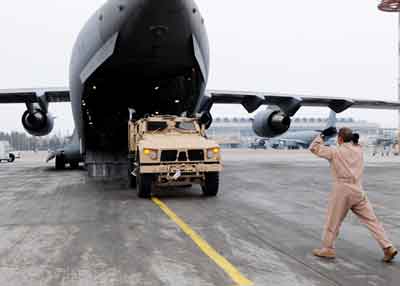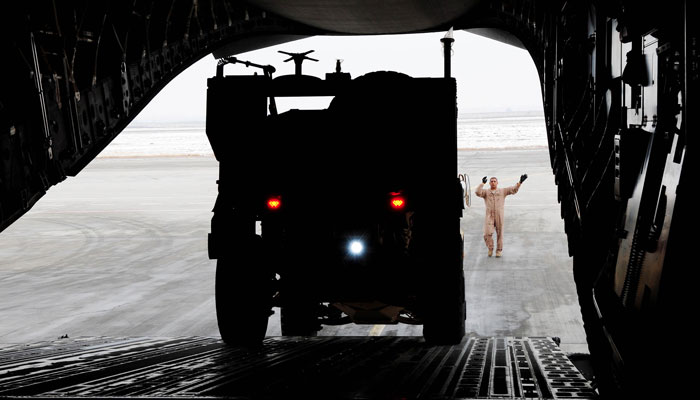As we highlighted shortly after the Obama Administration decision to surge troops to Afghanistan in the middle of winter, the logistics costs would be significant for such a decision. One of these costs was the leverage which the Russians would gain from the logistics underbelly to Afghan operations.
In this piece Richard Weitz discusses a key element of the leverage challenge, which the Afghan operations have underscored.
***

“U.S. Air Force Master Sgt. Nathaniel Starks 376th Expeditionary Security Forces Squadron,
Visitor Control Center, welcomes Colonel Melis Duchenbiev, Kyrgyz Ministry of Interior,
to the Transit Center at Manas, Kyrgyzstan, March 19th, 2010.
The Kyrgyz MOI toured the installation to get an overview of entry procedures,
security posts and patrols.”
(Credit: Senior Airman Nichelle Anderson, U.S. Air Force,
Transit Center At Manas, Kyrgyzstan, March 2010)
Although the debate continues over the origins and consequences of the regime change in Kyrgyzstan, attention in Washington, for better or worse, is fixated on whether the new Kyrgyz government will continue the U.S. lease to the air base at Manas international airport. The Pentagon considers the base vital for sustaining coalition military operations in Afghanistan. Although alternative routes for shipping U.S. and NATO military personnel and other urgent military exist, they have less capacity, take longer to use, are more expensive to operate, or are less secure.
After Uzbekistan evicted American military personnel from its territory in 2005, the Manas Air Base became the main U.S. military installation in the region. The base is co-located at Kyrgyzstan’s international airport, located over 30 kilometers (18 miles) east of the capital of Bishkek. The Pentagon has used the base to support U.S. military operations in Afghanistan since late 2001. The facility houses approximately 1,100 coalition military personnel. These are mostly French, Spanish, and especially Americans associated with the 376th Air Expeditionary Wing (AEW). Australia, Denmark, Italy, Netherlands, New Zealand, Norway, and South Korea have also used Manas to support their national contingents in Afghanistan, which under the auspices of the NATO-led International Security and Assistance Force (ISAF). The main purpose of the base is to provide logistical support for military operations in Afghanistan. Neither the 376th AEW nor any other NATO forces stationed at the base engage in direct combat operations.
Almost all American soldiers who deploy on the ground in Afghanistan enter and leave through Manas. They typically only remain for a day or two in Kyrgyzstan, sequestered on base and isolated from the Kyrgyz population to avert incidents. The base also serves as a major hub for moving other international troops into and out of Afghanistan, as well as for delivering equipment needed urgently or that is too sensitive to risk transporting by truck through Pakistan, where it could more easily be stolen or seized by Islamist insurgents, or by the northern distribution network, a lengthy rail and road system, with several routes that pass through the territories of Russia and various Central Asian countries. The recent surge in NATO military personnel operating in Afghanistan has considerably increased the coalition’s use of the Manas facility in recent months. Whereas in early 2009, some 15,000 American military personnel and 500 lbs. of cargo passed through the base while moving into or out of Afghanistan, in March 2010, the Air Force transported 50,000 NATO soldiers and even more equipment to and from Afghanistan on its C-17s.

In addition to ferrying forces and cargo into and out of Afghanistan, the personnel at the base support aerial refueling, airlifts, airdrops, and medical evacuations. In 2008, the American, French, and Spanish aerial tankers based at Manas, which includes a U.S. KC-135 Stratotanker squadron, conducted 3,294 in-flight refueling missions over Afghanistan, providing 194,453,400 lbs of gas to 11,419 aircraft. The base can also provide emergency aeromedical evacuation from the Afghan theater to hospitals in Europe or North America. Manas served as a staging area for relief efforts after the 2005 earthquake in Pakistan. The international airport’s two main assets are its relatively advanced facilities and its pivotal location. Its 4,200 meter runway, shared between the military and civilian airports, was originally constructed for Soviet bombers. It has proved uniquely capable among Kyrgyzstan’s airports of sustaining round-the-clock support for large military aircraft such as cargo and tanker planes. Their crew can make the 1,000-mile flight to Afghanistan in 90 minutes. The next closest air logistics hub, at Incirlik Air Base in Turkey, requires an 8-hour flight, along with mid-air refueling over the Black Sea, to Afghanistan.
Since the March 2005 Tulip Revolution, the Kyrgyz government has periodically threatened to abrogate the basing agreement or limit U.S. military operations at Manas. During the presidencies of both Askar Akaev, who governed Kyrgyzstan until March 2005, and his successor, President Kurmanbek Bakiyev, who ruled until April 2010, the base’s use appeared to have involved some controversial American payments, sometimes seen as bribes, to the president and other key Kyrgyz and their families. Some members of the Kyrgyz government criticized this practice, while others became annoyed when they did not receive similar inducements.
The U.S. government compensates Kyrgyzstan for use of Manas by negotiating commercial leases for various privately owned facilities and land in the base’s vicinity. The work at Manas also generates revenue and employment opportunities for local contractors and workers. The most valuable service contract is the millions of dollars spent each month on fuel for the airplanes. About 600 of the 750 contract employees at the base are Kyrgyz nationals. They receive wages that are approximately three times greater than that of the typical Kyrgyz worker. The personnel at the base also support local charities and community services. According to one calculation, the commercial activity associated with the base amounted to 7% of Kyrgyzstan’s GDP in 2006.
Despite these contributions, opinion surveys regularly show widespread opposition to the base among the Kyrgyz public. The widespread perceptions of corrupt business deals involving the base, as well as a series of bizarre incidents—a mysterious alleged kidnapping of an American female soldier, the collision of a U.S. plane with the Kyrgyz presidential jet, and the 2006 killing of a Kyrgyz truck driver and the subsequent decision to remove the soldier to the United States before he could stand trial in a local court—turned much of the population against the foreign military presence.
Observers have suspected that some Russian and Chinese officials have encouraged the Kyrgyz government to end the U.S. lease at Manas. In 2006, the Kyrgyz government signed a “protocol of intentions” that permitted U.S. access to the base under one-year renewable leases through July 2011. At the time, Kyrgyz authorities indicated they intended to allow American military deployments at Manas as long as the war in Afghanistan continued.
Starting in late 2008, rumors again surfaced that Russian representatives were pressing President Bakiyev to close Manas. Some sources reported that the Russians were offering large sums of money for the eviction. Influential members of the Kyrgyz parliament were also pressing the government to close the unpopular base, though others considered it important to keep both a Russian and an American military presence in their country as a form of geopolitical balance. On February 3, 2009, Bakiyev announced that he would end the lease because the United States had failed to pay sufficient rent for the base and because the Pentagon had repatriated an American soldier who killed a Kyrgyz truck driver rather than allow him to go on trial in Kyrgyzstan.

Credit: Senior Airman Nichelle Anderson, USAF,
376th Air Expeditionary Wing Public Affairs,
Transit Center At Manas, Kyrgyztan, January 2010
U.S. officials and commentators perceived a Russian hand behind the Kyrgyz decision. Bakiyev announced the closure in Moscow following a meeting with Russian President Dmitry Medvedev, immediately after the Russian government pledged to write off $180 million in debt, give $150 million in direct aid, and help subsidize the construction of the $1.7 billion Kambarata-1 hydropower plant with a special credit line. After several months of additional bargaining, however, Kyrgyzstan and the United States signed a new one-year lease on June 22. Under its terms, the Pentagon agreed to rename the facility a “Transit Center,” pay more rent and other financial benefits. The annual rent tripled from $17 million to about $63 million. In addition, the U.S. government is paying about $67 million for improvement to the navigation systems and other airport functions. An additional $51.5 million in U.S. assistance is to help the Kyrgyz government combat narcotics trafficking and terrorism as well as promote economic development. Whether Bakiyev had double-crossed Moscow or was simply leveraging Moscow’s offers of assistance to bargain for higher U.S. payments is still unclear. Although Russia provided $450 million in loans and other aid in late March 2009, it never opened the line of credit line for the Kambarata-1 plant.
Members of the transitional Kyrgyz government have made conflicting comments regarding the base’s future. No definitive decision looks likely until after the next Kyrgyz national elections occur later this year. Any Kyrgyz government would find it hard to relinquish the approximately $200 million in annual rent and additional U.S. payments directly related to the Manas base. Combined with other U.S. assistance, this sum is a large amount for an impoverished country whose annual government budget is only $5 billion and where the average per capita income is around $2,000. But the Russian government might be willing to offer more to secure the Americans’ removal, or at least threaten such action to coerce Washington and its allies to make concessions on other issues.
———-
***Posted on May 28th, 2010


